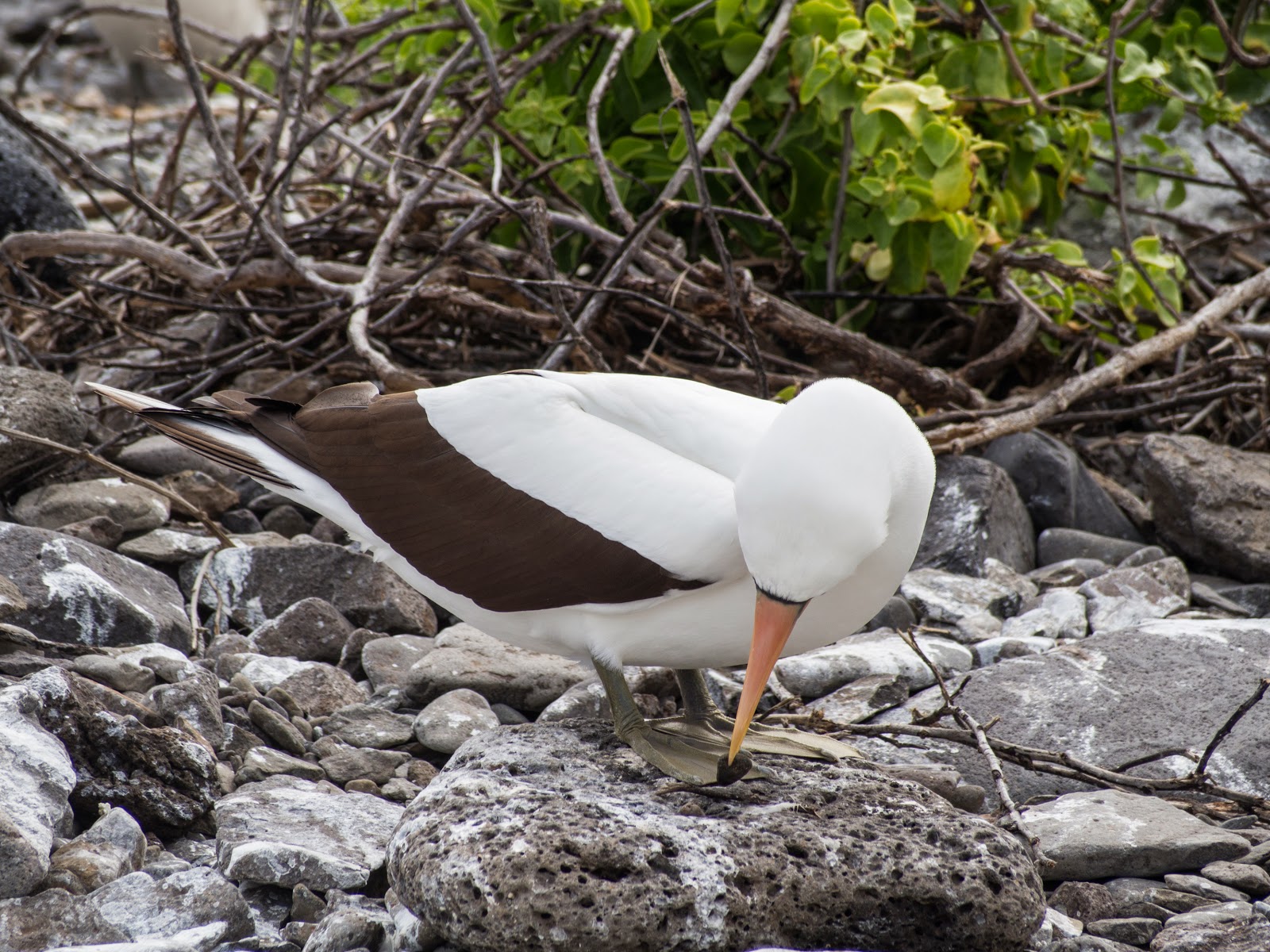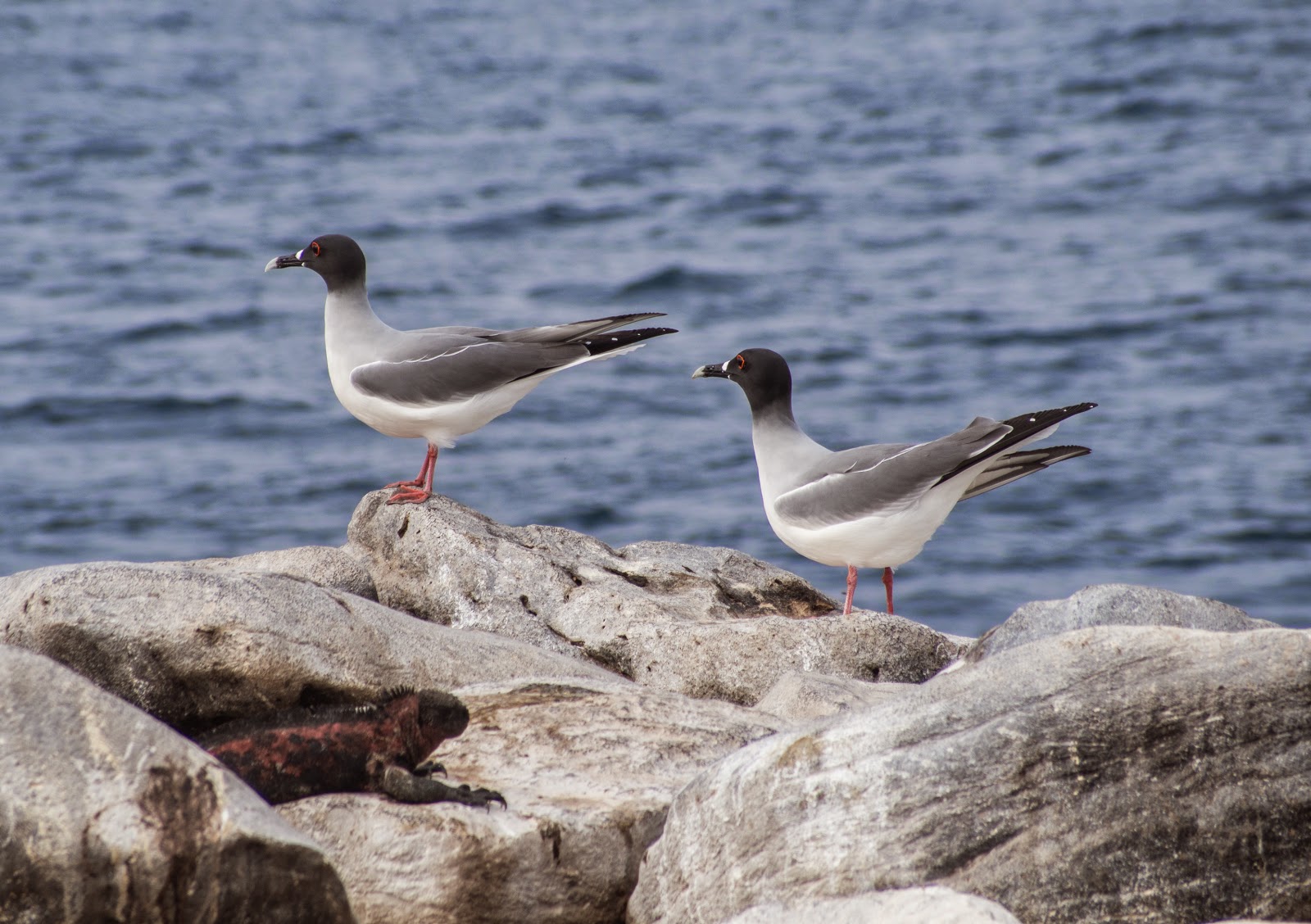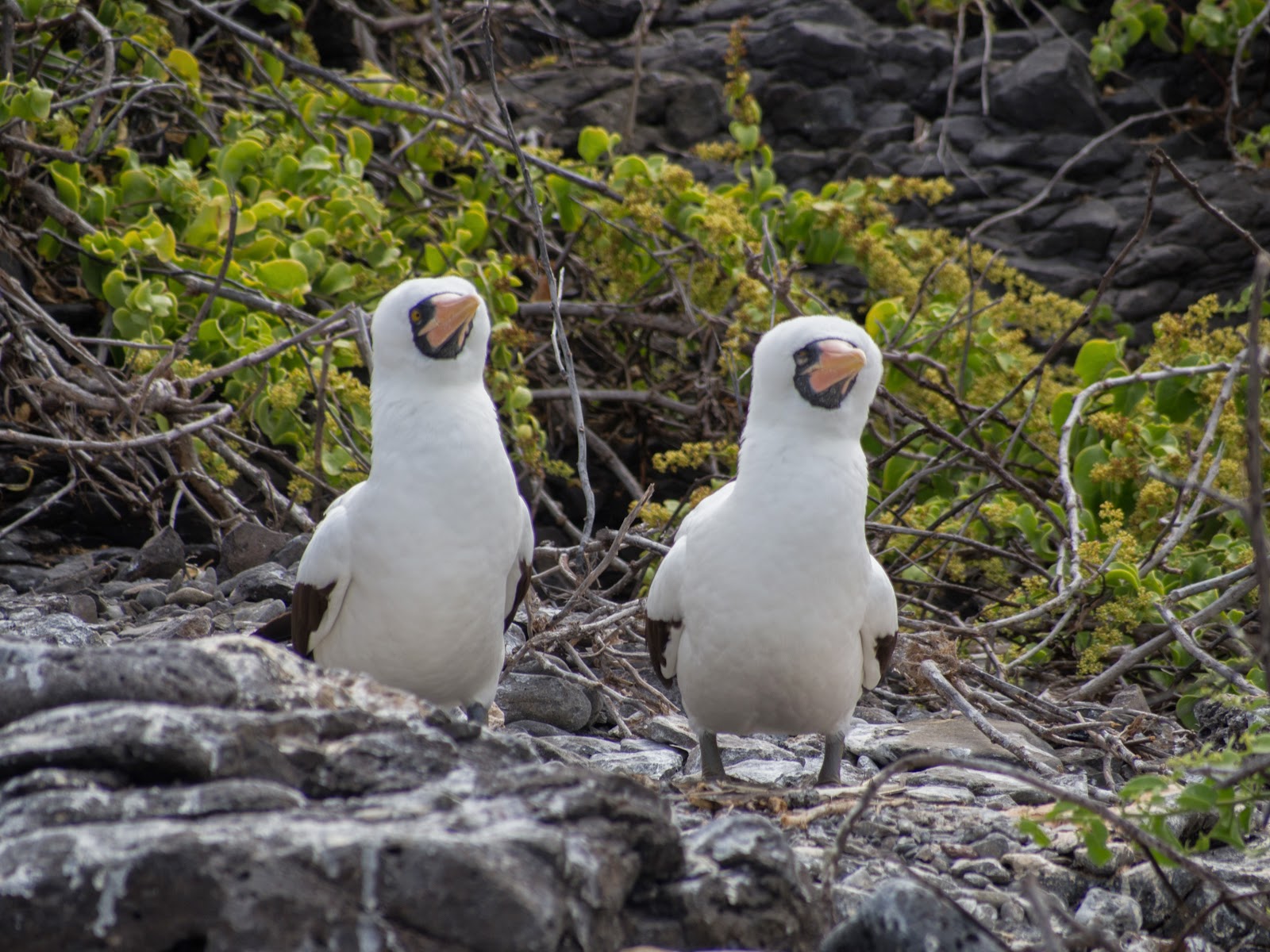Early morning wake up hearing the anchor chain rattling. We are at Espanola, the south-eastern corner of the Galapagos. The sky is completely clouded and a drizzle is coming down. I climb to the deck and find it all wet. It probably rained during the night.
This island is supposed to be the home of many nesting birds, like Genovesa. But, the sky is almost empty. I am not sure whether it is the light, which might make it harder to fish, or our location.
Our first excursion today is a dry landing at Punto Suerez, a point along the shore with a small lighthouse (really a beacon). By the time we go out on the pangas, the drizzle is gone, and it is starting to warm up. The sky is still gray without sun.
We land on a stair case leading along a short rock pier toward the point.
We reach a small sandy beach populated with sea lions, mothers and pups, some of them look very young. The pups make sounds like a groaning old men, which is quite entertaining, and the mothers answers with barks.
We see a mother taking her pup along the rocks toward the sea. The pup’s progress is comical, stumbling over rocks and sliding down others. But it keeps going with its mother’s encouragement.
All the rocks around us are covered with large marine iguanas. Here they are larger than those we saw before and have a more pronounced red coloring. The iguanas bunch up in groups on the rocks, waiting for the sun to show up.
We continue along a rocky path and after few meters reach another beach. Here older sea lion pups play together on the beach. The sea lion version of kindergarden. I guess their mothers are out feeding, or sleeping on the sand slightly further along the beach.
Intermixed with the sea lions are iguanas. I get a chance to do some close up photography on some of them.
After about 15 minutes, David collects us and we continue along the path. It takes us along the cliff’s edge, overlooking the sea. We encounter many blue-footed and masked boobies and seagulls.
The iguanas are also abundant and we observe one that has bright green color, indicating a mating display.
We descend with the path down to a rocky beach, and observe pairs of masked boobies. They seem to go through mating or bonding rituals. One of them (the male?) picks a small rock or a twig and after minutes of deliberation presents it to the other, who observes it and then adds it to a pile that might become the nest.
Another pair seem to be in a different stage. Every few minutes they go into an abrupt sequence of beak fencing movement, and as abruptly, though nothing happened, return to preening their feathers until the next round.
 |
| "Here is a nice stone just for you" |
 |
| "Lets check this stone, is it good enough?" |
 |
| While he is checking out stones, she is doing her feathers |
Another pair seem to be in a different stage. Every few minutes they go into an abrupt sequence of beak fencing movement, and as abruptly, though nothing happened, return to preening their feathers until the next round.
All in all, these rituals are very lethargic and slow paced. Of course there are iguanas here as well...
 |
| Huddle |
We climb back up to a rocky plateau that hosts an albatross colony. This was supposed to be the highlight of this excursion, but it seems that we are not in the right season. Instead of active mating rituals and nest building, we encounter some rather large chicks, sitting by themselves near their nests. We see two adults in the far distance and one that briefly flew above us.
 |
| Albatross! |
The albatross’ chick is a rather large fluffy and drab looking bird. It is the size of a large goose.
As we walk through this rocky field, we see in the distance a hawk soaring in the wind. After few minutes it flies across the field and disappears beyond a rocky outcrop.
We do see other birds fly by
 |
| Galapagos hawk! |
We reach a high observation point on the edge of a cliff. the vista is impressive. Below us is a rock shelf much closer to the sea level, and we can see the cliffs far out to both sides. Below us there is a blow-hole that regularly sends up a cloud of the spray up in the air. The wind is blowing and so the spray forms a screen that expand along the rocks.
On the cliff across from us we see a pair of sea lions resting. It is hard to imagine how they climbed this high from the sea level.
We walk along the high cliff. Across from us is an impressive pinnacle. On one of the rocks there are the dessicated remains of a large iguana. It looks like a picture from a horror scene.
As we continue on, the sun comes through the clouds. We walk away from the cliff’s edge and the breeze disappears. Suddenly feel the day’s heat is pronounced.
Along the path we encounter the hawk sitting on a rock. It seems awake, but stoically ignores the array of cameras pointing at it.
 |
| Abandoned? albatross egg |
Along the path we encounter the hawk sitting on a rock. It seems awake, but stoically ignores the array of cameras pointing at it.
The path leads us back to the kindergarden shore, and we return to the dock. The sun is out and we see large iguanas climbing down the rock and swimming out to the sea.
During a quick lunch the boat sailed around the island to Gardner Bay. The bay has a long stretch of white sandy beach. We landed on one edge of the bay. and were asked not to leave a particular stretch. On the way in we see a large dark brown shape on the rocks to our right. According to David this is the cadaver of a young humpback whale that washed from the ocean.
Along the beach there are small groups of sea lions. Each group of females and their young is shepherded by a dominant male. The male goes back and forth along “his” beach stretch and barks to announce his territory. These males are much larger and have more pronounced foreheads.
According to the documentary we saw yesterday, other males challenge him regularly and after few weeks of defending his territory and watching over it without rest, the dominant male looses to one of his opponents. Sounds like a tough world for the males. I am not sure whether after recuperating he goes back to reclaim the same harem, or whether he is wasted for the season.
The young pups were playing along the beach in the shallows. The dominant male makes sure that they do not stray outside the territory.
The briefing suggested that it might be nice to snorkel to a nearby rock cropping in the bay. According to David and the guide book, there was a shallow cave where white tip sharks rest during the day. Most of the crowed seemed reluctant to get wet, so I went in alone. Few minutes later Hans, Ruth, Kevin and Andrea join. The white sand in the bay is so fine that the waves kept disturbing it. The area close to the shore the water was totally milky. Further out it was still whitish but there was some visibility.
On the way to the rock we encounter a sting ray cruising the bottom.
The area close to the rock on the bay side was relatively shallow and a jumble of large rocks. Schools of surgeon fish and striped salima fish moving about the rocks.
Getting closer to the main rock tower proved to be harder as waves make a back and forth swell. Just as I was swimming around in the shadow, a large sea lion passes by. It totally ignored me and continued on its way.
Getting closer to the main rock tower proved to be harder as waves make a back and forth swell. Just as I was swimming around in the shadow, a large sea lion passes by. It totally ignored me and continued on its way.
I try to find the rock with the cave without success. The exposed rock that we saw from the shore was a small section of a much longer ridge. Snorkeling along the ridge I checkefew places that might serve as hiding place for sharks. In one of them I found a large shark sleeping. This is relatively deep for free dive, and I doubt that this was the intended location.
I continue circling the rock. The side facing the open sea is deeper. Here the waves are more pronounced and I have to work harder to keep away from crashing into the rocks.
After going around the mini-island once, I come across what I guess was the intended cave — a large concave area just below the tip of the rock cropping. I dive along the bottom twice without finding any sharks.
I return toward the beach, and midway meet Ilan. According to him, the beach is infested with large flies, maybe due to the whale corpse, which makes it unpleasant to sit there. I decide to join him and we go back toward the rock cropping and complete a circle around it, this time keeping bigger distance from the rocks.
We decide we had enough and return to the beach. The flies are indeed annoying, and we wait for the pangas to collect us back to the boat. At some point it seems that all of us had enough, but David is sitting back chatting with the guide from another boat, and seem happy to stay there until the end of our allotted beach time.
Once we were all on board, the boat starts sailing toward our next stop - San Cristobal. As usual there are frigates tagging along. One of them even landed on the boat.
The afternoon is relatively quiet, people use the time to rest or read. Suddenly, I hear the cry "dolphins!".
The joy of watching dolphins is always amazing. They are so playful.
 |
| dolphins surfing in front of the boat |
The joy of watching dolphins is always amazing. They are so playful.
In the evening, just before dinner, we have a farewell drink with all the crew to say our goodbyes and thank you.
By now we are moored in San Cristobal. This is a smaller town than Puerto Ayora, with few fisherman boats, and two or three cruise boats.
David suggest that if we are interested, we can go for an evening in the town. Most of us decide to skip this.
Later in the evening, as some of us sit in the living room, a cry from outside. We go out and find that a large sea lion decide that the back deck is a great place for resting.
I try to photograph it, the light is very dim and so the result is very shaky. It allowed me to come close to about a meter and half from him. If I crossed that imaginary line, it growled, like a dog. I got the hint, and stayed back.




























































No comments:
Post a Comment